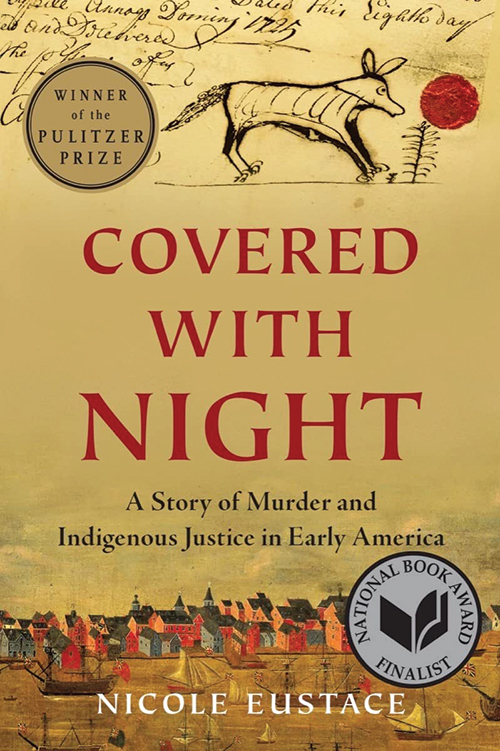
Covered with Night: A Story of Murder and Indigenous Justice in Early America
Reviewed by Michele Sands
November 1, 2023
By Nicole Eustace. Liveright, 2021. 464 pages. $29.95/hardcover; $20/paperback or eBook.
In the Iroquois Book of the Great Law, the expression “covered with night” refers to grief. In 1722, Sawantaeny, a Seneca hunter, was killed near Philadelphia by two Quaker brothers when he refused to accept rum in exchange for his pelts. To the colonists (included here, Pennsylvania, New York, Maryland, and Virginia), the death threatened the fragile peace with the Indigenous nations following William Penn’s recent death. To the Haudenosaunee nations, Sawantaeny’s death was a grief that needed reparation. The death also afforded them an opportunity to further establish their philosophy of civil society, so natives and newcomers could live in kinship.
This dense, absorbing history, which was awarded the Pulitzer Prize last year, covers the year following the death of Sawantaeny, leading up to the Great Treaty of 1722. Throughout the telling, Eustace threads the tension between the native reliance on freedom of movement and expanding kinship with settlers, and the colonists’ drive for English individual property law and capital punishment as they lay the foundation of a new nation.
The book weaves stories from the lives of native and colonial women, enslaved people, indentured servants, and prosperous Philadelphians. It is rich with details of the printing trade; colonial architecture; and farming and hunting, both native and colonial.
Several individuals stand out. “Captain Civility,” Taquatarensaly, the Susquehannock translator and diplomat, walked hundreds of miles between Albany and Philadelphia in his quest for brotherhood and equality—tenets Penn alluded to—over colonist patriarchy. James Logan, prosperous Quaker and Pennsylvania council secretary, faithfully recorded everything transpiring in the councils between the two groups, even when the purport of his writing seems to elude him. Governor William Keith, an Anglican newcomer sent from England as Penn’s successor, sees himself as the hero peacemaker, establishing English law in the new colony, while furthering acquisition of land and mineral rights for himself.
The substantial primary sources for the book include native artifacts such as wampum, or beaded story belts; contemporaneous colonial newspapers; Quaker quarter session minutes; council minutes of Philadelphia and the Province of Pennsylvania; and journals, inventories, and wills of Keith, Penn, and prominent Quakers. From John and Edmund Cartlidge, the slayers, to Jonathan Dickinson, pillar of Philadelphia, Quakers often do not come out favorably, even in their own words. And yet the Great Treaty of 1722—known more as a property transfer than a treatise on restorative justice—is the oldest recognized treaty in effect today, and would likely not have been possible without the foundation Penn had laid.
Those of us beginning to formally or informally acknowledge Indigenous and enslaved labor realities in our institutional and national history are searching the past for perspectives other than those seen through the eyes of the “victors.” Covered with Night is one such valuable source, as it explores the Indigenous values of kinship and reparations, bringing us face-to-face with important queries: Who are our kin? How can we repair what has been broken for centuries? Moving from ignorance to acknowledgement is one step—at least—toward uncovering our grief and finding a way forward, here and now.
Michele Sands is a retired librarian and was a member of North Branch Meeting near Wilkes-Barre, Pa., part of Upper Susquehanna Quarterly, before moving to Collington, a Kendal retirement community near Washington, D.C. She was involved in developing Collington’s recently unveiled land and labor acknowledgment.



Comments on Friendsjournal.org may be used in the Forum of the print magazine and may be edited for length and clarity.